In the past centuries, especially in the 15th and 16th centuries, under the Safavid Empire, Iranians built many towers that were known as pigeon towers. These towers were built as nests for pigeons. But what was the real purpose of a building of this magnitude? Why haven’t smaller structures been used to nest pigeons?
After the Persian Qanat, which is one of the most amazing historical constructions of the ancestors of today’s Iranians, Iranian pigeon tower should be considered the second and most important historical monument in the prosperity of agriculture in Iran.
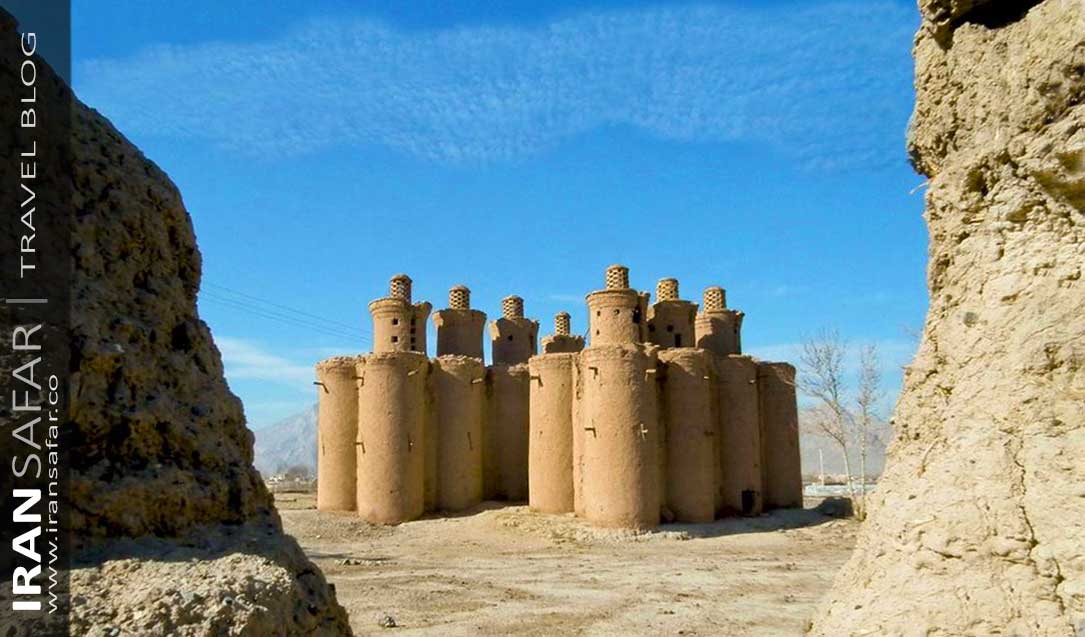 Quintuplet pigeon towers of Ejgerd, Isfahan province
Quintuplet pigeon towers of Ejgerd, Isfahan province
What is a pigeon tower?
In bygone eras, towering structures served purposes beyond human dwelling, exemplified by the construction of pigeon towers. These towers were specifically designed for pigeons, recognizing their significance not for their meat but for their valuable excrement, a potent fertilizer used in melon fields.
Pigeon droppings, renowned for their effectiveness as fertilizer, made these towers essential. The structures were crafted to attract pigeons, providing them nesting spaces and facilitating the collection of their valuable droppings. These towers, characterized by brick-shaped formations adorned with a blend of plaster and adobe, stand out as exceptional examples of pigeon houses, marking a unique architectural solution born out of the practical needs of the time.
History of Iranian Pigeon Towers
The origins of most pigeon towers in Iran trace back 400 years to the Safavid era, particularly during the reign of Shah Abbas I. However, archaeological studies reveal simpler versions were constructed even earlier, dating back over 1,200 years. Although not as intricate, these ancient pigeon towers still stand as remnants of early architectural solutions.
Historically, central Iran boasted over 3,000 pigeon towers. Some European travelers have mentioned in their travelogues that there were more than 3000 pigeon towers in the central regions of Iran. Jean Chardin (1643-1713) says:
Regrettably, only 700 endure today, with Isfahan province housing 300 recognized towers, and a mere 70 formally registered. The decline can be attributed to the Qajar era, where hunting interests led to a reduction in bird populations, including pigeons. The advent of chemical fertilizers further marginalized the demand for natural fertilizers like pigeon droppings.
As urban development surged without principles, many pigeon towers faced abandonment and destruction. However, some were fortunate to undergo restoration by the cultural heritage organization, standing as resilient reminders despite the challenges posed by unchecked urbanization.
Features of Pigeon Towers
The outskirts of Isfahan and some desert cities, feature captivating and peculiar pigeon towers, distinct from their European counterparts. Unlike European Dovecot (also Dovecote), where pigeons were raised for meat, Iranian pigeon towers served as guano factories. They produced fertilizers for the region’s prized melons.
The towers’ intricate designs, decorated with ornate cupolas and muqarnas friezes, make them charming and worth traveling great distances to witness. These buildings were usually cylindrical and had mesh windows. The size of the windows was such that only pigeons could enter through it and in this way they were safe from predatory birds such as crows, eagles and owls. In most of the towers, a white plaster band was worked around the tower, as well as raised and protruding brick congresses at a higher height, which is to deter minks and snakes. To repel insects and pests, the owners of the pigeon houses used plants such as frankincense and pepper. Also, a well was dug in the middle of this tower so that the pigeons could have access to water. The materials used in the construction of the pigeon house were clay and mud, so the weather was cool in summer and warm in winter.
Architecture
The architecture of pigeon towers of Iran typically involves features that provide comfort and safety for the pigeons. The architectural design is ingenious, aiming to maximize the number of pigeon nests with minimal materials, resulting in tall, empty, yet sturdy and compact structures. Impressively sized, reaching 10.5-18 meters in height, these sturdy towers exhibit fine proportions and diverse designs. Constructed from mud-brick, each tower, though unique, adheres to a common plan. The structure comprises an outer drum, internally buttressed for stability, and an inner drum rising about one-third of the main height. Their internal structure is designed in a way that has maximum pigeon nests. There are 5000 nests in a big tower with dimensions of 30 x 25 x 20 cm. These towers are typically circular (although a few cases adopt a cubic design) showcasing variable heights and mesh decorations. In regions like Khwansar and Golpaygan, cube-shaped towers of varying dimensions can be observed, either clustered together or scattered across the fields. The simplicity and efficiency of their construction highlight the resourcefulness of traditional Iranian architecture.
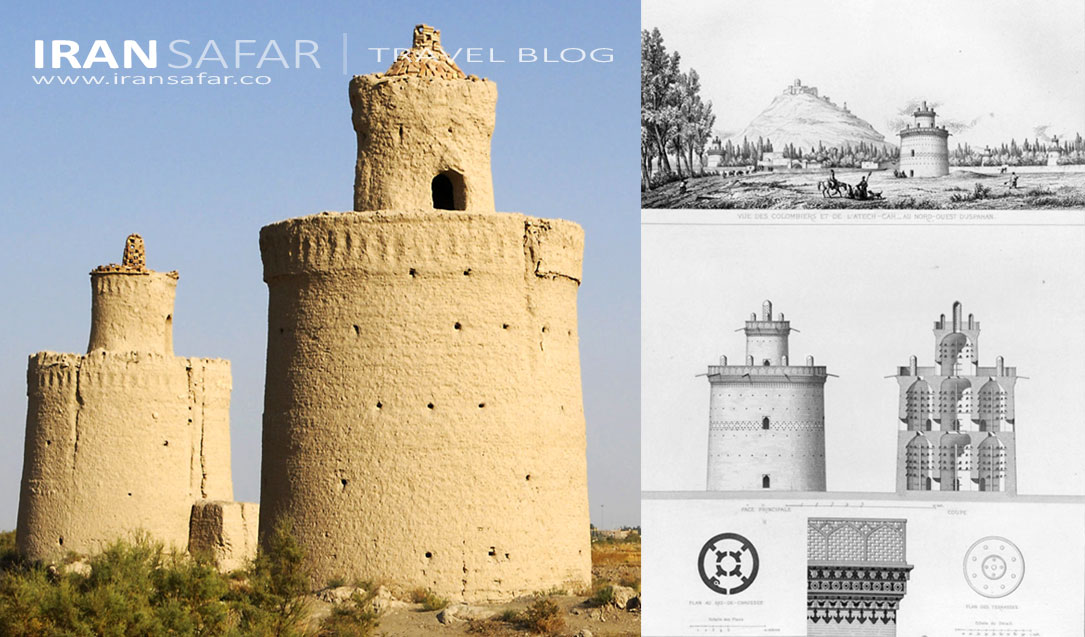 Interior plan of a pigeon tower, 18th c
Interior plan of a pigeon tower, 18th c
Building Materials
Pigeon towers of Iran, also known as Kaboutar Khan, have been built in various regions with different climates, and the construction materials and methods often reflected the environmental conditions of the area. While the specific materials and techniques may vary, using clay, straw, and salt in construction suggests adaptation to a desert climate. Pigeon towers primarily employ raw clay as their main building material, coated with a layer of mud and lime.
Clay
Clay is a versatile building material that has been used for centuries in various architectural styles. It provides excellent thermal mass, helping to regulate temperature by absorbing and releasing heat slowly. In a desert climate, where temperatures can be extreme, this quality can contribute to maintaining a more stable and moderate environment inside the pigeon tower.
Straw
Straw has been traditionally used as a building material for its insulation properties. It can help keep the interior of the pigeon tower cool in the hot desert sun and provide insulation against temperature fluctuations. Additionally, straw is lightweight, making it easier to work with in construction.
Salt
The use of salt is interesting and less common in traditional construction materials. While salt can contribute to the strength of certain types of materials, it’s essential to consider the potential effects of salt on the long-term durability of the structure. Salt can absorb moisture and, in some cases, lead to corrosion or deterioration of certain materials.
While these structures evoke memories of a rich past, they stand as remnants of a bygone era, as chemical fertilizers have supplanted the traditional role of these unique and historic pigeon towers.
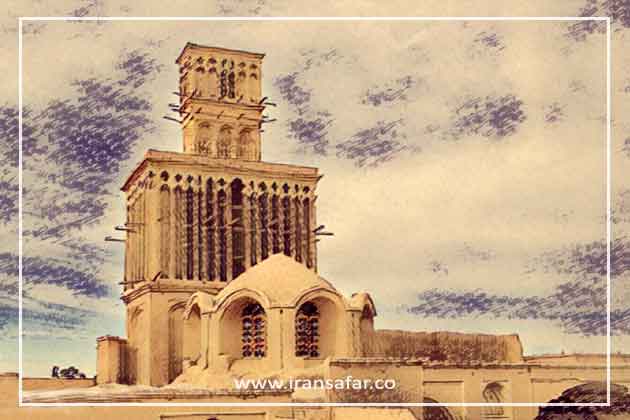
Architectural Features in Ancient Persia
Ancient Persia, also known as the Persian Empire, holds a fascinating architectural heritage that continues to awe and inspire people to this day. The architectural features of ancient Persia showcase the brilliance of their builders and the richness of the culture of Iran. In this article we will talk about the various architectural features that […]
Guano & Gunpowder production
Additionally, the pigeon’s guano that was collected from pigeon towers of Iran played a role in gunpowder production. Guano, which is a type of bird or bat droppings, was historically used as a source of nitrogen for the production of gunpowder. The key ingredient in gunpowder is potassium nitrate (saltpeter), which provides the necessary oxygen for the combustion of other components. Guano is rich in nitrogen, and through a series of chemical processes, saltpeter can be extracted from it. Here’s a simplified overview of how gunpowder was made from guano in the old days.
Process Steps
Collection of Guano: Guano deposits were collected from the pigeon towers.
Leaching: The guano was collected and soaked in water to create a liquid solution. This process is known as leaching. During leaching, the water-soluble components of guano, including potassium nitrate, would dissolve into the water.
Filtration: The liquid solution was then filtered to separate the liquid from the solid components. The liquid portion contained dissolved potassium nitrate.
Evaporation: The filtered liquid was left to evaporate, leaving behind crystals of potassium nitrate.
Refinement:The extracted potassium nitrate was then further purified through crystallization processes to remove impurities.
Gunpowder Mixture: The purified potassium nitrate was combined with other ingredients of gunpowder, which typically include charcoal (for carbon) and sulfur. The proportions varied, but a common ratio was around 74.8% saltpeter, 13.3% charcoal, and 11.9% sulfur.
Mixing and Grinding: The ingredients were thoroughly mixed and ground together to create a fine powder.
Final Product: The resulting mixture was the gunpowder, ready for use in firearms, cannons, or other applications.
Guano & Leather industry
Indeed, pigeon guano has been historically used in various industries, including leather tanning. The ammonia present in the guano is a key component that aids in the tanning process.
Remarkable Pigeon Towers of Iran
Here is a list of famous pigeon towers that you will be able to visit during your visit to Iran:
Meybod pigeon tower
During the Qajar era, in the city of Meybod, they built a huge pigeon tower in the southeastern part of the old rampart of the city with clay and mud in the shape of a cylinder. The substantial height of 8 meters and three stories suggests careful planning to accommodate a large number of pigeon nests. The presence of 4,000 nests with dimensions of 20 x 20 cm each emphasizes the scale and efficiency of the construction, highlighting the importance of pigeon breeding in the local culture. On the roof of the building, 4 small turrets and one big turret have been created for the movement of pigeons.
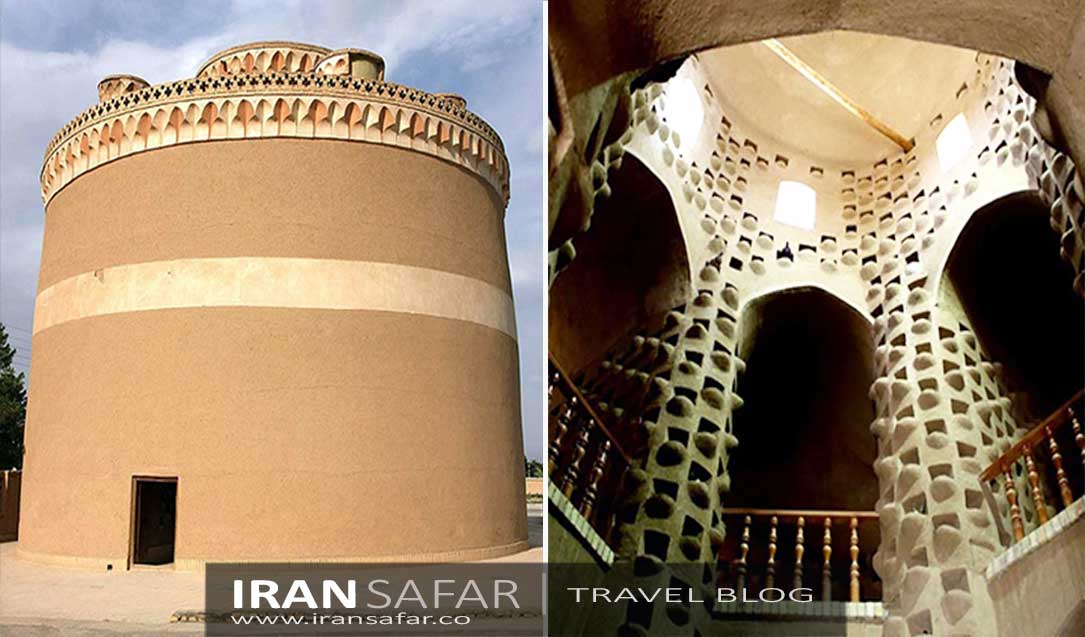 Meybod pigeon tower, Meybod, Iran
Meybod pigeon tower, Meybod, Iran
The fact that the Pigeon Tower of Meybod has been well-maintained and restored contributes to its appeal to visitors. The restoration efforts have likely preserved not only the physical structure but also the historical and cultural significance of the monument.
This Pigeon Tower is registered with the number 1691 in the list of national works of Iran. Visitors are allowed to enter the tower by purchasing a ticket from ticket office in the courtyard of the complex.
Mardavij Pigeon Tower – Isfahan
Mardavij pigeon tower is one of the most famous ones in Isfahan. One of the big and famous neighborhoods of Isfahan is known as Borj, which is named after the pigeon house. Mardavij tower is designed like a flower with eight circles around it and a bigger circle in the center. The height of this tower reaches 18 meters and its diameter is 16 meters. This tower has three floors and 15 thousand nests are installed in it. The dimensions of the mesh windows are such that only pigeons can pass through it. This tower has been registered in the list of national works of Iran.
Azar Bahram Pigeon Tower – Isfahan
One of the most special pigeon towers of Isfahan is called Azar Bahram. This tower has been converted into a cultural library-cafe with a space for studying on the roof. This tower has three floors and is 400 years old.

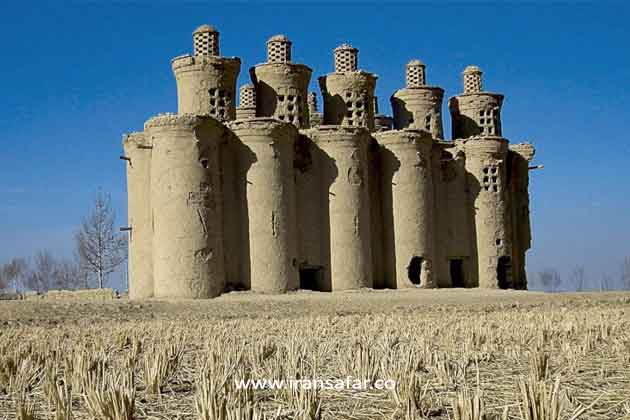

Message by: Masoud Sadeghi
Mobarakeh, which is located 45 kilometers southwest of Isfahan, has one of the most beautiful pigeon towers in Iran, which is called “Dah-Gholu pigeon towers” of Mobarakeh. It dates back to the early 20th century and was recently restored. The restoration and strengthening of the Pigeon Tower has been carried out recently. It will be good to also put some information and photos of this monument in this page.